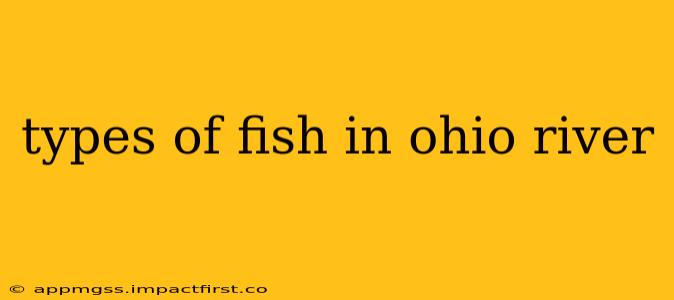The Ohio River, a major tributary of the Mississippi River, boasts a diverse and fascinating ecosystem teeming with various fish species. From popular game fish sought after by anglers to smaller, less-known inhabitants, understanding the fish populations within this vital waterway is crucial for conservation and responsible enjoyment. This comprehensive guide explores the many types of fish found in the Ohio River, addressing common questions and providing valuable insights for anglers, researchers, and anyone interested in the river's rich biodiversity.
What kinds of fish live in the Ohio River?
The Ohio River supports a wide array of fish species, categorized broadly into several groups. These include:
-
Game Fish: These are highly sought-after by anglers and often command high recreational value. Popular game fish in the Ohio River include various species of bass (largemouth, smallmouth, spotted), walleye, sauger, channel catfish, flathead catfish, and muskie. These species often require specific habitat conditions and play a crucial role in the river's ecosystem.
-
Panfish: Smaller, but equally important, panfish offer excellent sport fishing opportunities and contribute significantly to the overall biodiversity. Common panfish species include bluegill, crappie (black and white), and redear sunfish. These fish serve as a vital food source for larger predators.
-
Forage Fish: These smaller fish form the base of the food web, providing sustenance for larger predatory fish. Examples include gizzard shad, threadfin shad, and various minnows. Their populations directly influence the abundance of larger fish.
-
Other Species: The Ohio River is also home to a number of other fish species, including carp, suckers (various species), sturgeon (although populations are recovering from historical declines), gar, and various types of minnows and darters. These contribute to the overall health and complexity of the river's ecosystem.
What is the most common fish in the Ohio River?
While the exact abundance fluctuates annually depending on environmental factors, channel catfish are often cited as one of the most common and widespread fish species throughout the Ohio River. Their adaptability and reproductive success contribute to their widespread presence. However, the "most common" designation varies depending on the specific location and time of year.
What are the best fish to eat from the Ohio River?
Consuming fish from any waterway requires caution, as levels of contaminants can vary based on location and time of year. It's always advisable to check advisories from local health departments or environmental agencies regarding fish consumption. Generally, fish with shorter lifespans tend to have lower concentrations of contaminants than larger, longer-lived fish. Panfish and smaller game fish are often considered safer options, but always consult official advisories before consuming any wild-caught fish from the Ohio River.
What is the biggest fish in the Ohio River?
Historically, the largest fish recorded in the Ohio River have been sturgeon. While their populations have been significantly reduced due to overfishing and habitat destruction, they still represent a potential for large catches. Flathead catfish also grow to impressive sizes and are strong contenders for the title of "biggest fish." The size of a fish is heavily influenced by its access to food and the overall health of its environment.
Are there any endangered fish in the Ohio River?
Yes, several fish species within the Ohio River basin are classified as endangered or threatened. These often reflect the broader impacts of habitat loss, pollution, and invasive species. Specific species vary, and information on their conservation status can be obtained from state and federal wildlife agencies.
Conclusion:
The Ohio River’s fish diversity is a valuable natural resource, supporting both recreational fishing and the broader ecosystem. Continued monitoring and conservation efforts are crucial to maintain the health and abundance of these fish populations for future generations. Remember to always adhere to fishing regulations and practice responsible angling techniques to ensure the sustainability of this valuable aquatic resource.
